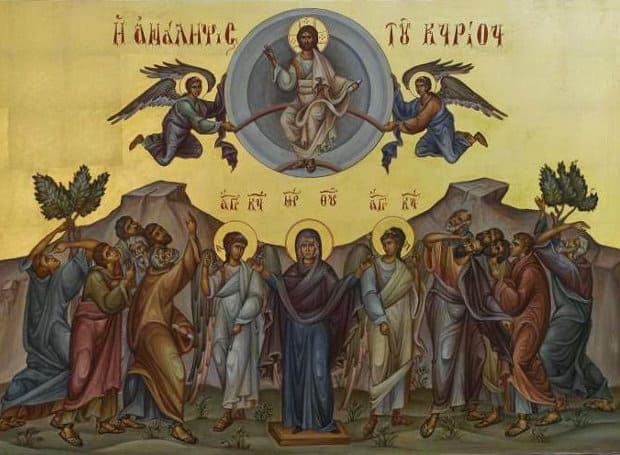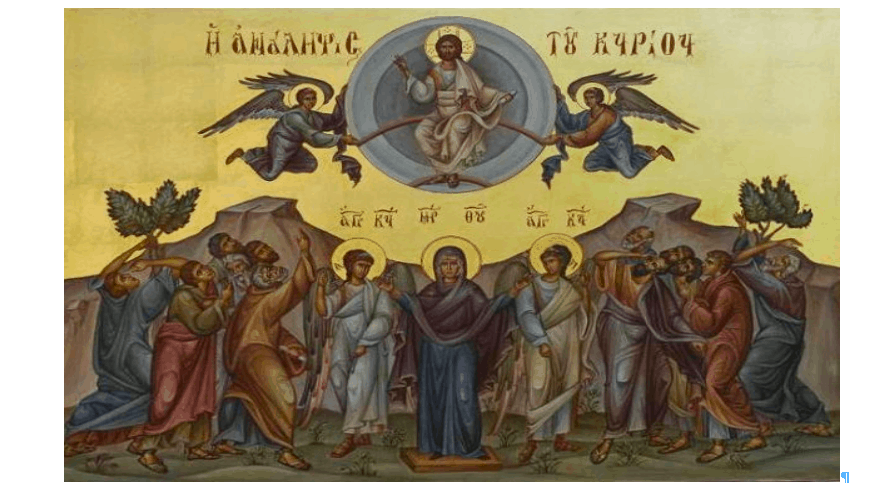
Today is the Feast of the Ascension of our Lord God and Savior Jesus Christ, which is celebrated each year on the fortieth day after the Great and Holy Feast of Pascha (Easter). Since the date of Pascha changes each year, the date of the Feast of the Ascension changes. The Feast is always celebrated on a Thursday.
The Feast itself commemorates when, on the fortieth day after His Resurrection, Jesus led His disciples to the Mount of Olives, and after blessing them and asking them to wait for the fulfillment of the promise of the Holy Spirit, He ascended into heaven.
The story of the Ascension of our Lord, celebrated as one of the Twelve Great Feasts of the Church, is found in the book of the Acts of the Apostles 1:3-11. It is also mentioned in the Gospels of Mark (16:19) and Luke (24:50-53). The moment of the Ascension is told in one sentence: "He was lifted up before their eyes in a cloud which took Him from their sight" (Acts 1:9).
Christ made His last appearance on earth, forty days after His Resurrection from the dead. The Acts of the Apostles states that the disciples were in Jerusalem. Jesus appeared before them and commanded them not to depart from Jerusalem, but to wait for the "Promise of the Father". He stated, "You shall be baptized with the Holy Spirit not many days from now" (Acts 1:5).

After Jesus gave these instructions, He led the disciples to the Mount of Olives. Here, He commissioned them to be His witnesses "in Jerusalem, and in all Judea and Samaria, and to the end of the earth" (Acts 1:8). It is also at this time that the disciples were directed by Christ to "go and make disciples of all nations, baptizing them in the name of the Father and the Son and the Holy Spirit" (Matthew 28:19). Jesus also told them that He would be with them always, "even to the end of the world" (Matthew 28:20).
As the disciples watched, Jesus lifted up His hands, blessed them, and then was taken up out of their sight (Luke 24:51; Acts 1:9). Two angels appeared to them and asked them why they were gazing into heaven. Then one of the angels said, "This same Jesus, which is taken up from you into heaven, shall so come in like manner as you have seen Him going into heaven" (Acts 1:11).
For forty days after His Resurrection, Our Lord Jesus Christ remained on earth. Filled with the glory and honor of His Divinity, He appeared to His Disciples at various times and places. By eating and drinking with His disciples and conversing with them about the Kingdom of God, our Lord Jesus Christ assured them that He was Truly alive in His Risen and glorified Body. (The glorification of Jesus refers to His Crucifixion, Resurrection, and Ascension into heaven. When we speak of Christ's glorified Body, we refer to Its honor, splendor, majesty and visible radiance - it gave off rays of bright Light!).
The time span of forty days (40) is used symbolically in the Holy Scripture and by the Church indicate that an appropriate amount of time has passed for "COMPLETENESS". [The rains of the Great Flood lasted for forty days. Christ prayed in the wilderness for forty days. We fast for forty days to prepare before the feasts of the Holy Nativity and the Resurrection (Pascha).
The Ascension is a sign and symbol of the Second Coming of Christ and the Final Judgment. Christ will return to the earth in the same manner as He left it. When the Risen Lord returns again in glory, God's will for mankind will be fulfilled.
Jesus Christ completed His earthly mission of bringing salvation to all people and physically was lifted up from the world into heaven. The meaning of the fullness of Christ's Resurrection is given in the Ascension. Having completed His mission in the world as the Savior, He returned to the Father in Heaven Who sent Him into the world. In ascending to the Father, He raises earth to Heaven with Him.


